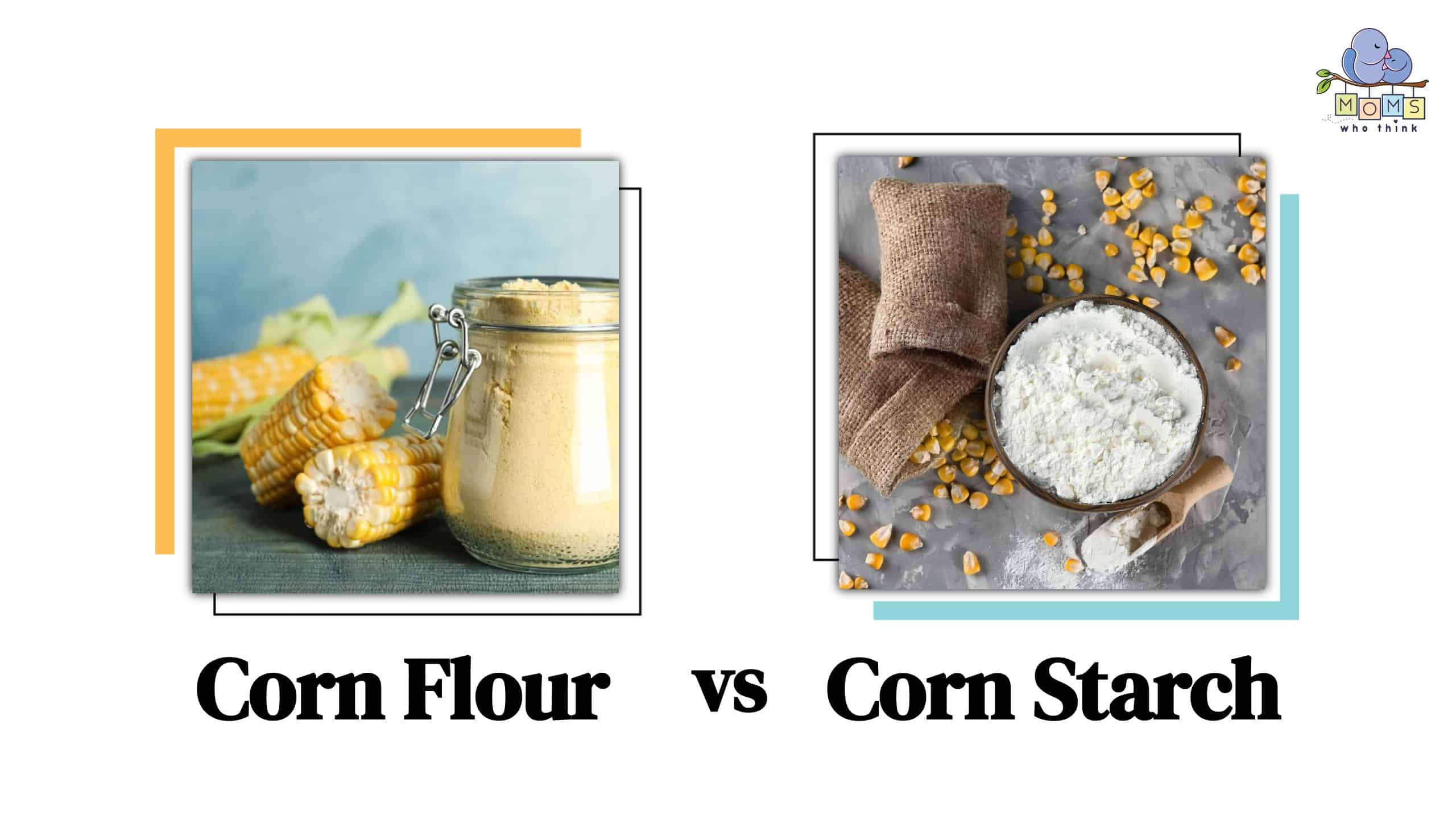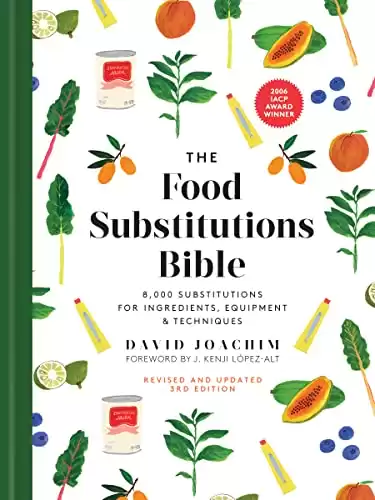Corn flour and cornstarch are essential and fantastic ingredients for baking and other food recipes. They are common; however, some people may be confused by their difference, considering they are both from corn. From their appearance, corn flour is a yellowish powder created from dried, finely ground corn. On the other hand, corn starch is a fine white powder made from the corn kernel. Additionally, corn flour is used similarly to most flours, while corn starch is an effective thickener. This article expounds more on these ingredients; what they are, their variances, nutrient profile, flavor, processing, and much more.
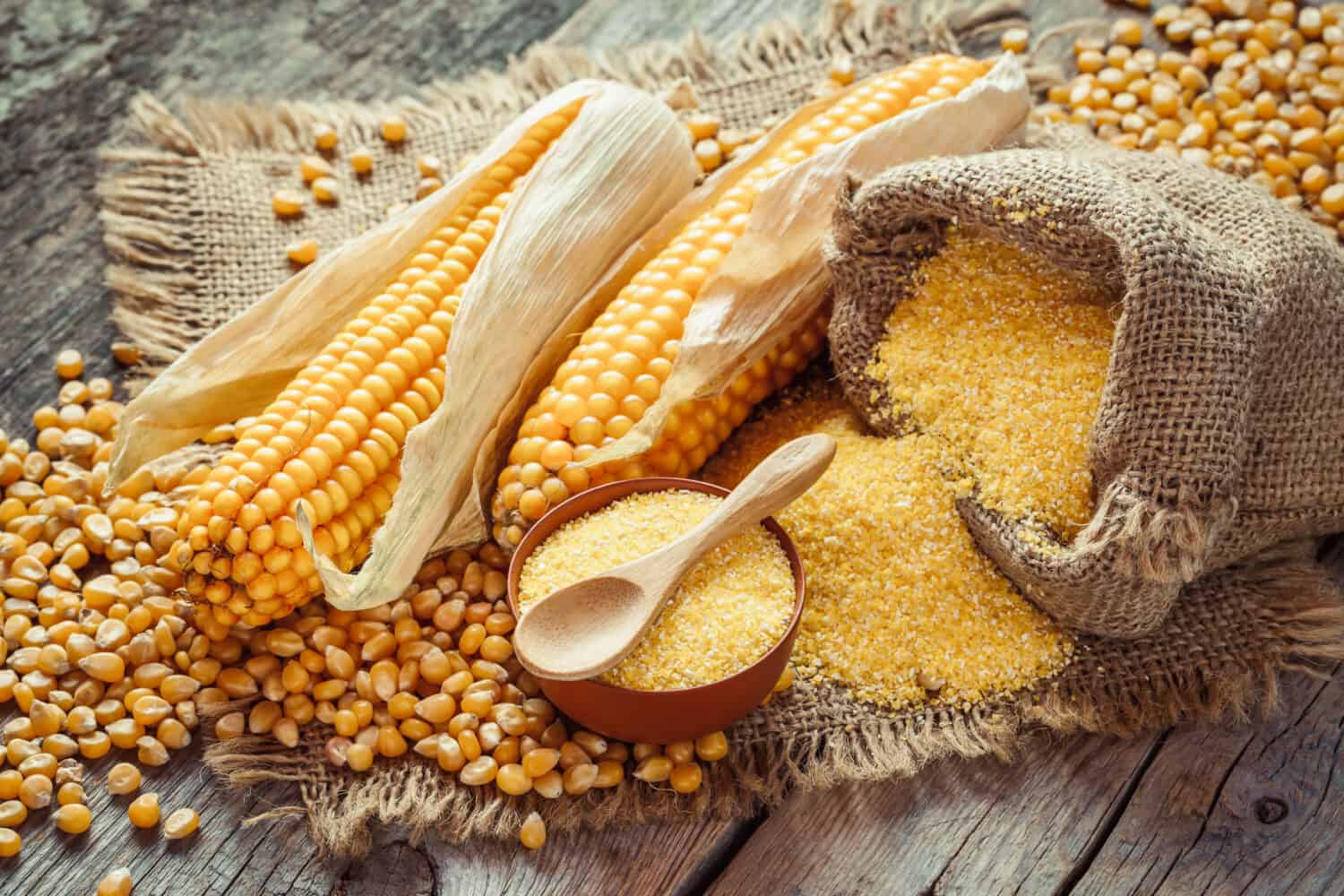
©Chamille White/Shutterstock.com
Corn Flour vs. Corn Starch: How Different Are They?
Have you thought about the differences between corn flour and corn starch? These two ingredients sound so similar that they may be confusing, especially in countries where their names are interchangeable. The first point of differentiating them is through their appearance. Corn flour is yellow, while corn starch is white. However, you can find white corn flour in stores though it's not as common as the yellow kind. Despite their appearance, they differ in flavor, texture, and use.
Since corn flour and corn starch come from corn, you may think they taste the same. However, this isn't the case because they have entirely different flavors. Corn flour has a strong, earthy, sweet taste that's hard to bypass. It's also somewhat noticeable in the smell during cooking, even before the tasting. Cornstarch is usually flavorless, with no distinct smell. The latter will only produce a sour taste when bad, so look out for that when cooking, as it may affect the taste of your food.
Corn starch adds texture to recipes instead of flavor. It's a great thickening agent for soups, stews, gravies, and sauces, so you achieve your desired consistency while maintaining the taste. Corn flour mildly alters the flavor of baked goods like bread, biscuits, waffles, pancakes, and other pastries.
Nutritional Profiles of Corn Flour vs. Corn Starch
Corn flour and corn starch are high-carbohydrate foods, but the flour has more nutrients than the corn starch. This is because of the amount of processing the starch has undergone, unlike the flour. Both condiments are gluten-free. Those who prefer such foods can comfortably use them without no harmful effects.
Corn starch has slightly more calories than corn flour, i.e., 381 and 361 per 100g serving, respectively. Corn flour has a good percentage of protein, which is excellent for its baking purpose and the body generally. It's great for muscle building and increasing blood levels, but you can't depend solely on it. Corn starch has 0.3 grams of protein. It's one of the reasons you can't use it for baking since the baked goods won't hold well. It also has no fat and fiber, while corn flour has 1.2 grams of fat and 2 grams of fiber per serving.
Corn starch has more carbohydrates than corn flour. However, they are both weight-gaining ingredients that you need to take moderately. Baked foods that involve corn flour are known for the weight increase factor due to sugars, fats, and carbs. But, corn starch comes in closely due to its high amounts of carbohydrates. In addition to the high protein and fiber amounts, corn flour has iron, potassium, magnesium, B vitamins, and other nutrients. Corn starch lacks B vitamins, and other nutrients are in minimal amounts.
- The must-have convenient reference guide for every home cook!
- Includes more than 8,000 substitutions for ingredients, cookware, and techniques.
- Save time and money on by avoiding trips to grab that "missing" ingredient you don't really need.
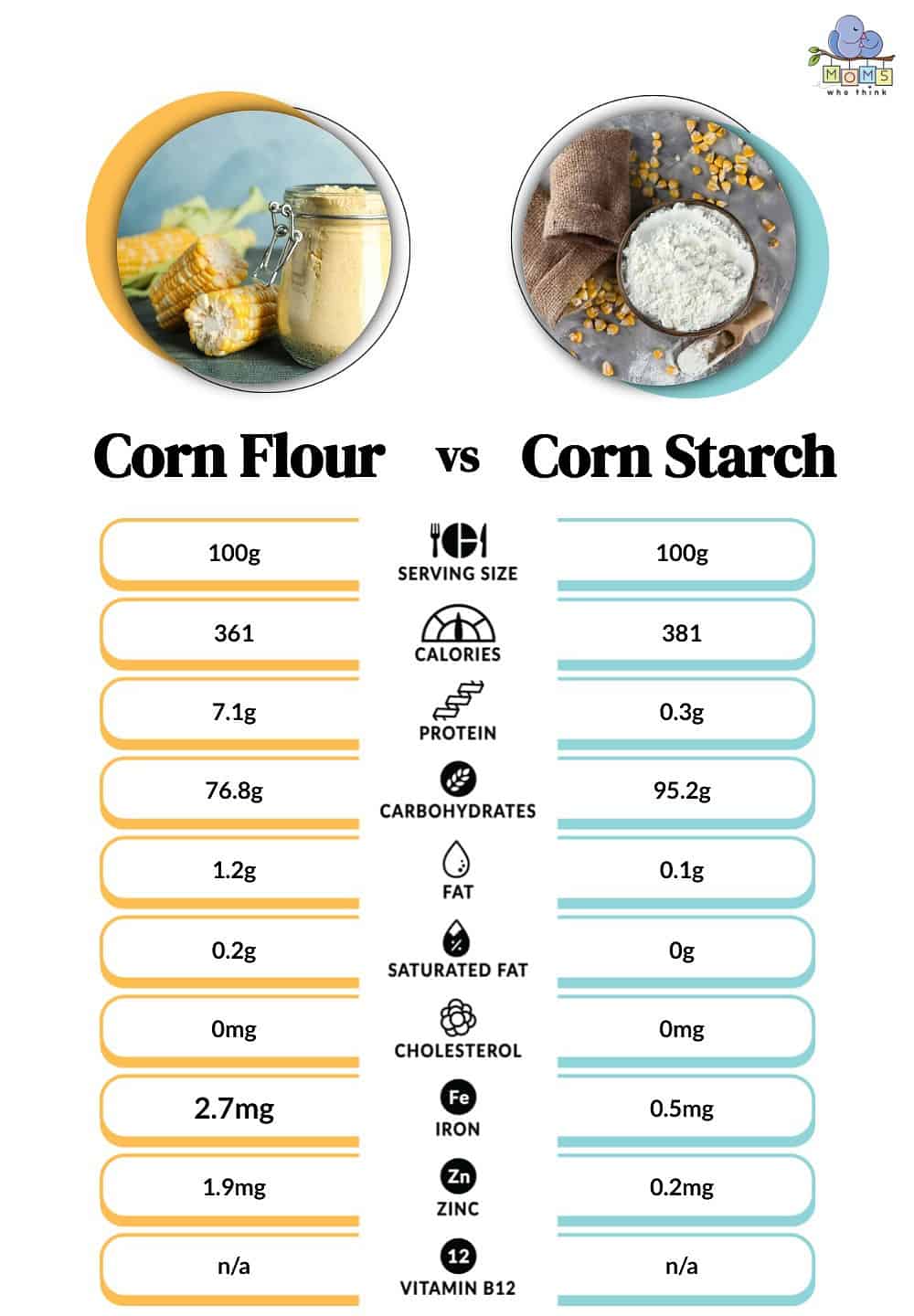
What is Corn Flour?
Corn flour is flour made by grinding dried corn. The corn is primarily yellow, hence the flour's typical yellowish color, but if the corn is white, the corn flour is usually white. The flour contains the entire grain, including its kernel, germ, hulls, and endosperm. Do you ever ask yourself why a type of flour is called ‘whole grain‘? This is the reason why, and corn flour isn't any different. The corn kernel contributes mainly to the corn flour's nutrients, such as protein, fiber, starch, vitamins, and minerals.
Corn flour is made from ground corn kernels. There are a variety of ways to make corn flour, but most manufacturers use dry milling or wet milling techniques. Dry milling uses steel rollers to crush dried corn kernels into smaller pieces, which are then ground into what we know as corn flour. Wet milling uses water and chemicals to break down the grains before they are dried out again and ground into flour.
Corn flour comes as a fine powder with a smooth texture. It has a solid sweet, and earthy flavor that resembles cooked corn. Since the taste isn't significant in cooked foods, corn flour is a versatile product, great for baking, grilling, and frying to create the perfect crunch on food.
Types of Corn Flour
A wide variety of corn flour types exist within the market today; each possessing unique characteristics and attributes achieved through specific treatments. This has given these flours several colors and textures that attribute to their versatility. Here are some common types of corn flour:
Yellow Corn Flour: Characterized with a mild flavor tone alongside a thickness made from its high starch content, yellow corn flour excels at fulfilling thickener needs for soups, sauces, and gravies. It is also useful while baking items like tortillas, biscuits, etc.
White Corn Flour: With its distinctiveness incited by pronounced flavors complemented with minimalism regarding starch quantity, white corn flour earns its place among baked goods appealing to those experimenting with texture instead of overpowering influences on taste alone. Its optimal usage ranges from cakes, muffins, and pastries, besides serving well as a staple element in preparing dishes such as polenta/grits.
What is Corn Starch?
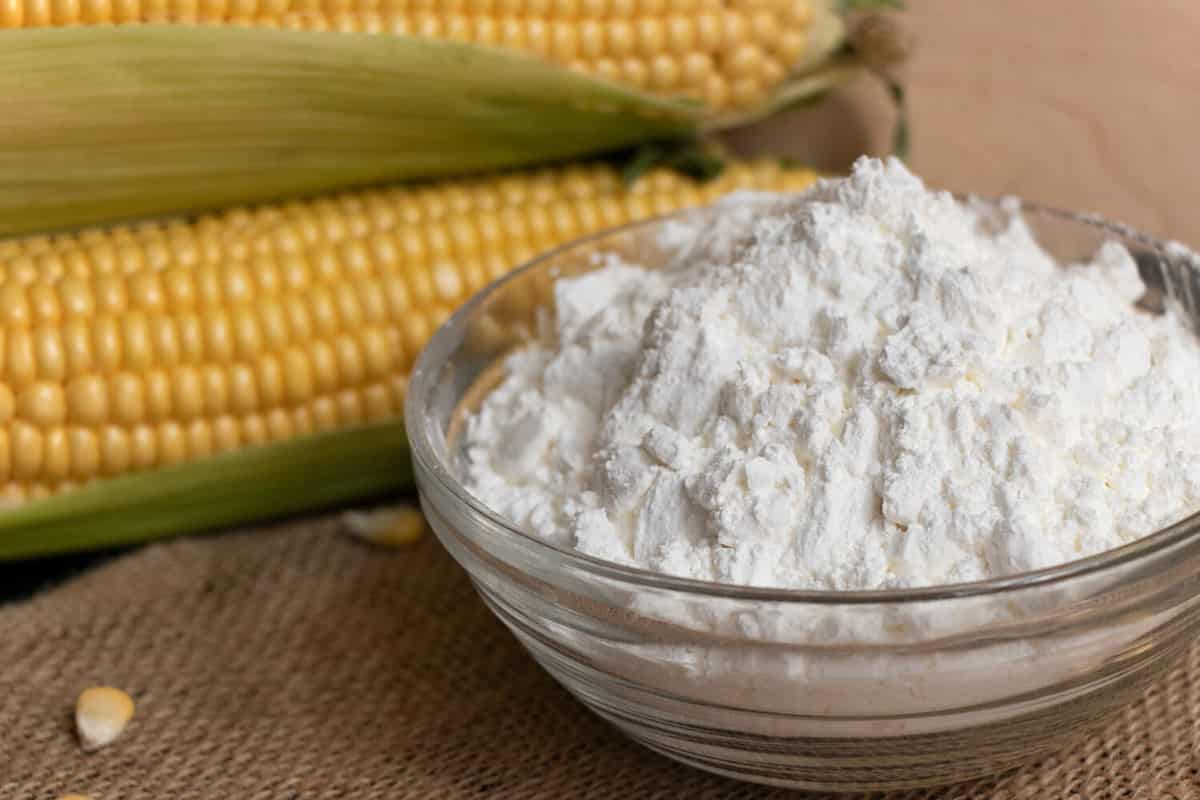
©Juli_li_Photographer/Shutterstock.com
Similar to corn flour, corn starch is also a popular ingredient. It appears like a white, chalky fine substance made from the corn kernel's starchy part or endosperm. For this reason, corn starch is packed with carbohydrates and starch and lacks fiber, protein, and other essential nutrients.
Corn starch is an excellent thickening agent perfect for soups, sauces, gravies, and other liquid foods. It's usually flavorless, adding no taste to the dish or altering its original flavor. Mix the cornstarch with cold water or the preferred liquid to form a slurry when cooking. Adding it directly to the hot liquid causes lumps that remain uncooked, something very undesirable to bite on.
Types of Corn Starch
There are 3 main types of corn starch:
Regular corn starch: This is the most common type of corn starch and it is used in many food products, such as sauces and gravies. It is also used in cosmetics, pharmaceuticals, and industrial applications.
Modified corn starch: Modified corn starch is made by treating regular corn starch with acids or enzymes to make it more soluble or less sticky. The process is called “modification.” Modified corn starches include waxy maize starches, which are used in snack foods; high-amylose maize starches, which are used in baked goods; and dextrinized maize starches, which are used in instant puddings, pie fillings, and canned frostings.
Organic corn starch is made from organically grown corn kernels that have not been genetically modified (GM). Organic corn starch may be processed into different types of organic food products such as syrups or powders for use in manufacturing other products.
Can You Substitute Corn Flour for Corn Starch and Vice Versa?
Corn flour and corn starch appear similar. They are both made from corn, used for cooking, and share some nutrients; however, it's impossible to interchange them. Corn flour is protein-based and gluten-free, while corn starch is starchy and gluten-free. The protein in corn flour adds strength and elasticity to baked goods. So, when used as a thickening agent, the product is dense, crumbly, or of poor consistency. Interchanging corn flour with corn starch for baking isn't a good idea. The latter lacks fat and protein which help baked goods hold well. Some cooks use corn flour as a thickening agent, but as mentioned earlier, it doesn't give the best results.
Best Substitutes for Corn Flour
Corn flour is a favorite for baking and cooking, but it can be expensive, or simply inaccessible for some reason. If you're trying to save money, or are looking to try something out of the ordinary, there are plenty of good substitutes that will give you the same results as corn flour.
Here are some of the best substitutes for corn flour:
Rice flour
It's a great option when your flour is finished. It appears like a starchy white powder made from finely ground rice. It's also gluten-free, suitable for individuals wanting to avoid gluten foods.
Rice flour is a great alternative to corn flour. It has a very similar consistency and can be used for most recipes that call for corn flour. In fact, it's often used as a substitute in some Asian cuisines, including Thai and Japanese cooking.
There are two types of rice flour: glutinous rice flour and non-glutinous rice flour.
Glutinous rice flour is made from sticky white rice polished with the bran layer intact. This type of rice has a high starch content but when cooked, the starch becomes gummy or gluey – hence the name “glutinous.” Glutinous rice can also be called sweet rice or sticky rice (as opposed to its counterpart known as waxy or rough rice).
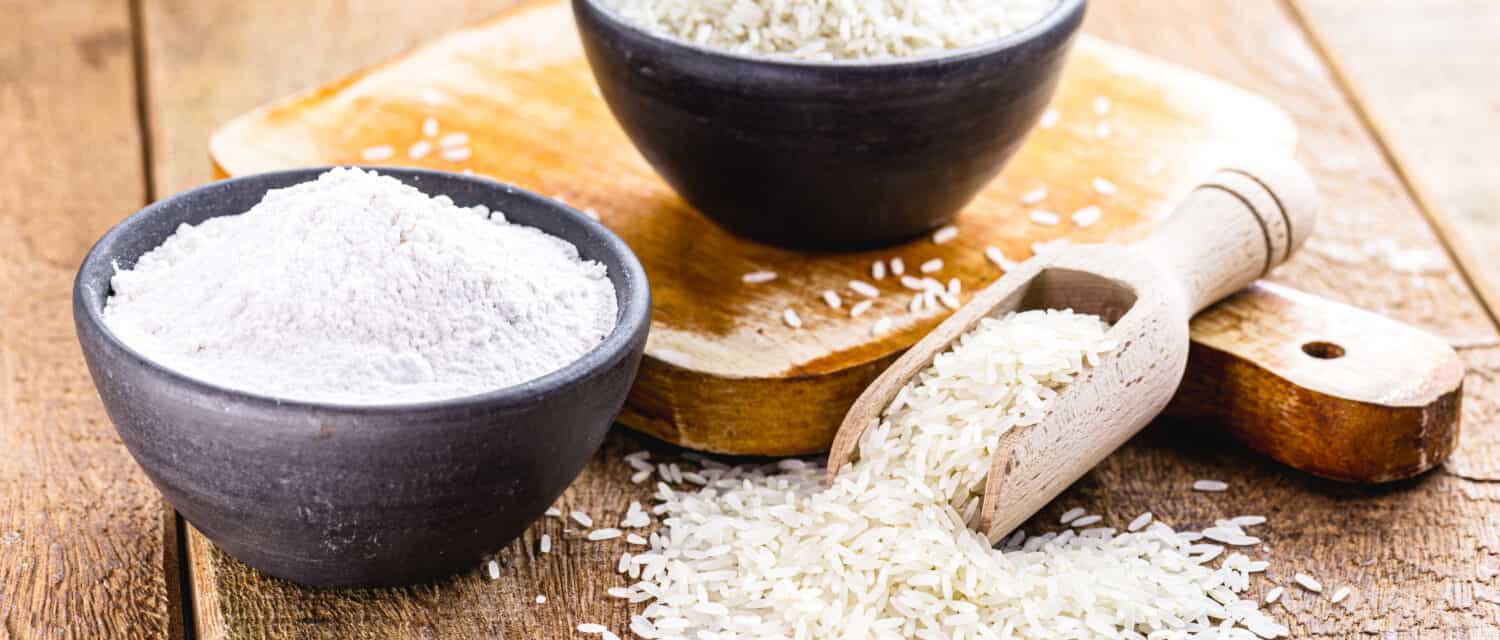
©RHJPhtotos/Shutterstock.com
Rice flours are typically made from brown or white long-grain rice since these varieties tend to have higher starch contents than short-grain rice like Arborio, which are more suitable for risotto dishes. Though promising, rice flour does not provide a similar crunch to corn flour on foods. If you were adding a tablespoon of corn flour, replace it with two of rice flour.
All-Purpose flour
The flour comes from wheat grains, milled to produce a white powder. The fine texture allows you to bake bread, cakes, muffins, pastries, etc., but the products are chewier and thicker than when using corn flour.
Corn meal
Corn meal is dried corn grounded to the desired texture. Cornmeal is no stranger substitute if you don't have access to fine-ground corn flour. Preparing yourself with its attractive features makes it impossible not to use it as your next best choice!
Upon switching over from finely ground-corn flours to coarser versions such as cornmeal; be prepared: you will notice several differences. These nuances come in the form of its texture-wise surface (coarse and grainy) and discolored grounded kernels.
A result of this change can be less light and fluffy recipes, yet nothing that could not be worked around. With a still remarkable outcome, cornmeal offers diversity as a substitute, still being adaptable for most substitutes.
Cornmeal may seem like the wildcard option on paper, but it does offer more than its texture changes. It stands out in this category as one of the few substitutes to continue retaining nutritional aspects even in grinding down a commodity such as corn. Even as a substitute, it still contains nutrients such as fiber, and protein as well as B vitamins like thiamin and niacin.
When tackled with creating a variety of dishes like sweet desserts or savory polenta that allow flavor complexity to flourish – Cornmeal suits it all! So why not mix up your dough with this inspiring ingredient? The coarser nature juxtaposes the bread's extra flour delicately for a truly unique taste experience that caters to those who appreciate an evident texture difference in their finished product- something different than traditional wheat-based loaves!
- The must-have convenient reference guide for every home cook!
- Includes more than 8,000 substitutions for ingredients, cookware, and techniques.
- Save time and money on by avoiding trips to grab that "missing" ingredient you don't really need.
Masa Harina
It's a Mexican ingredient similar to dough flour. During processing, manufacturers dehydrate the dough to give it a fine texture, like corn flour. It makes the baked goods dense and slightly thicker but still lighter than other substitutes.
Best Substitutes for Corn Starch
Some products come in handy for both corn flour and corn starch replacement. Like corn flour, you can use rice flour, all-purpose flour, corn meal, and Masa Harina in place of cornstarch. Other substitutions include;
Arrowroot powder
It's a favorite go-to choice for many people. Unlike corn starch, it has a flavor and may enhance the taste of a dish. Getting the correct consistency when using arrowroot powder is easy, but best if used on sauces or soups, you will serve immediately. Replace a tablespoon of corn flour with one of arrowroot in all dishes.
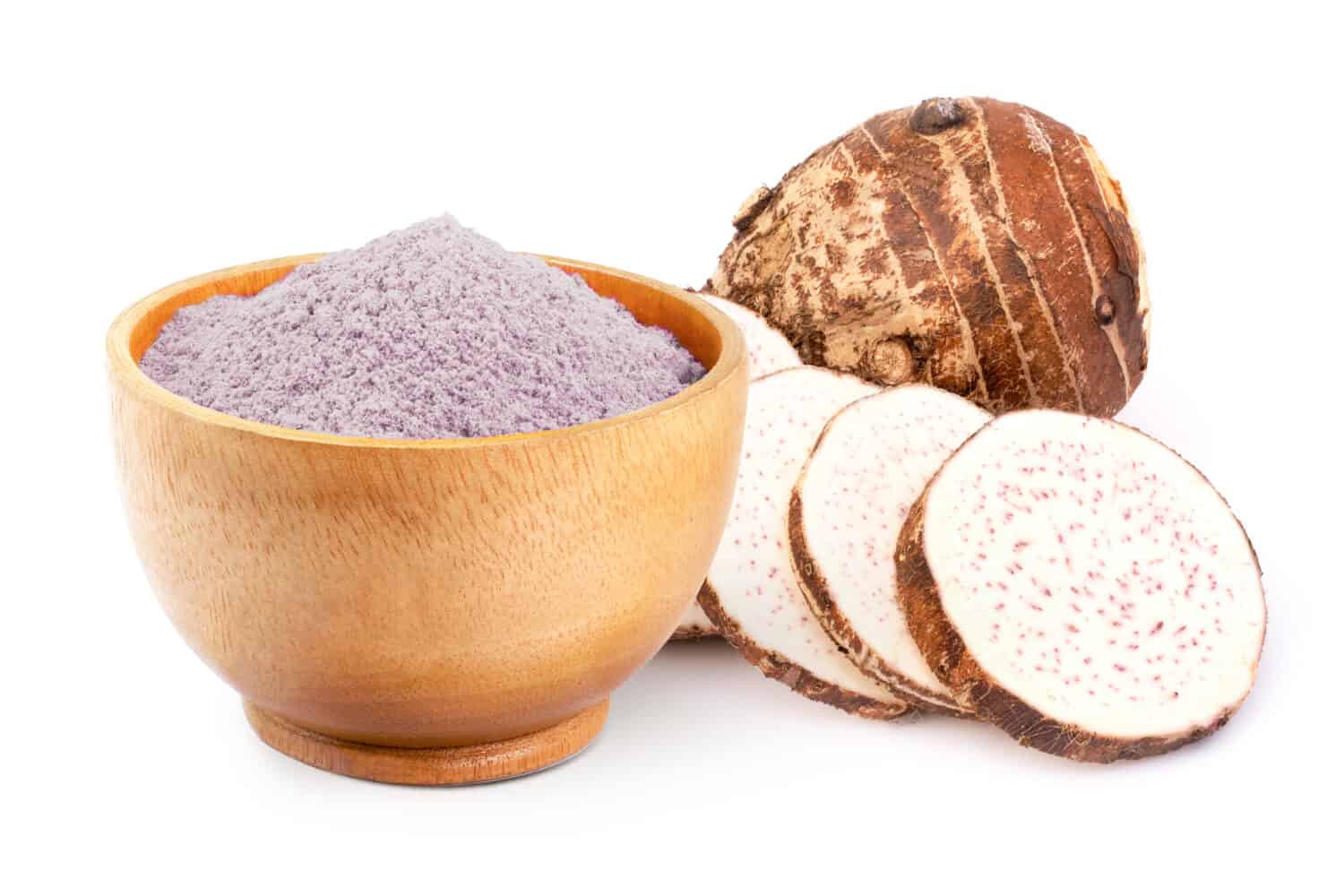
©NIKCOA/Shutterstock.com
Ground Flaxseed
Ground flaxseed helps thicken liquid dishes and is full of nutrients helpful to the body. Note that flaxseed is slightly bitter, so use it on more flavorful dishes to mask the taste. When cooking, substitute a tablespoon of cornstarch with half a tablespoon of ground flaxseed and mix with two tablespoons of water.
Tapioca flour
Tapioca flour is an alternative to corn starch and other gluten-free flours. It has a creamy texture that can be used in baking and cooking.
Tapioca flour is made from the cassava root (Manihot esculenta). The roots are boiled, peeled, and dried, then ground into flour. Tapioca flour is also known as tapioca starch or cassava starch. By weight, it's about 75% starch and 25% protein. The protein makes it more nutritious than cornstarch, but not as nutritious as whole grains like quinoa or brown rice.
The flavor of tapioca flour is mild and slightly sweet. It absorbs moisture well and combines well with other flours in baked goods like cookies, cakes, and muffins.
Tapioca flour has no gluten so it can be used by those following a gluten-free diet. It's also high in fiber, which makes it good for digestive health.
Conclusion
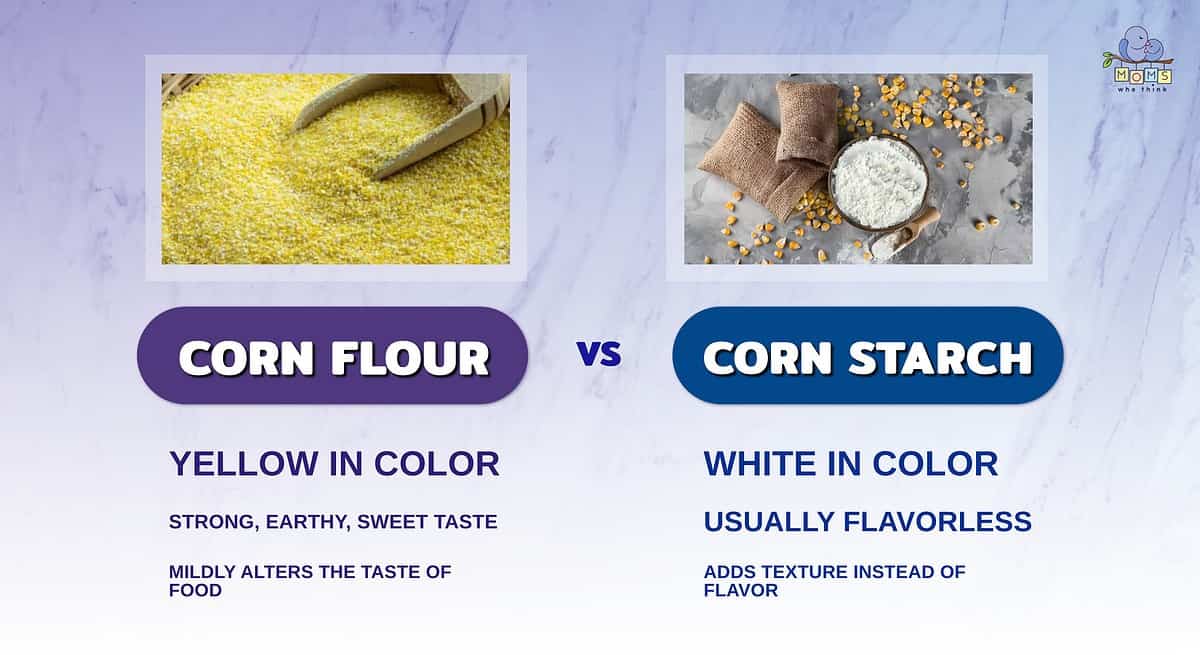
- One of the easiest ways to tell these two pantry staples apart is by color. Corn flour is yellow, while corn starch is white.
- Corn flour has a strong, earthy, and sweet taste. It also has a distinct smell out of the bag. Corn starch, meanwhile, is almost always flavorless and odorless. If your corn starch has a strong odor, it has more than likely spoiled.
- Corn starch is used to add texture to food, while corn flour will give it a bit of flavor. Keep this in mind if you choose to use corn flour for your baking.
Corn flour and corn starch originate from corn and have different primary functions. The first is for baking purposes, to get that mighty crunch, while the last acts as a thickening agent. Corn flour is yellowish, while corn starch is white. Corn flour seems better than corn starch regarding nutritional value; however, both have high levels of carbohydrates that can negatively affect the body.
Take a look at this Boston Cream Pie Cupcake recipe:
Print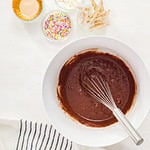
Boston Cream Pie Cupcakes
Ingredients
For the filling:
1 1/3 cups heavy cream
3 large egg yolks
1/3 cup sugar
1/8 teaspoon salt
4 teaspoons cornstarch
2 Tablespoons unsalted butter
1 1/2 teaspoon vanilla extract
For the cupcake:
1 3/4 cups all-purpose flour
1 cup sugar
1 1/2 teaspoons baking powder
3/4 teaspoon salt
12 Tablespoons unsalted butter, cut into 12 pieces and softened
3 large eggs, at room temperature
3/4 cup whole milk, at room temperature
1 1/2 teaspoons vanilla extract
For the glaze:
8 ounces bittersweet chocolate, chopped
2/3 cup heavy cream
1/4 cup light corn syrup
1/2 teaspoon vanilla extract
Instructions
1. For the filling: Bring the cream to a simmer in a medium saucepan over medium heat.
2. Meanwhile, whisk the egg yolks, sugar, and salt together in a medium bowl, then whisk in the cornstarch until pale yellow and thick, about 30 seconds.
3. Slowly whisk the hot cream into the egg mixture, then return the mixture to the saucepan and cook over medium heat, whisking constantly, until thick and glossy, 1-2 minutes.
4. Off the heat, whisk in the butter and vanilla.
5. Transfer the mixture to a small bowl and refrigerate until chilled and set, about 2 hours.
6. For the cupcakes: Adjust the rack to the middle position and preheat oven to 350°F. Grease and flour 12-cup muffin tin.
7. In the bowl of a stand mixer, whisk together the flour, sugar, baking powder, and salt.
8. On medium-low speed, beat the butter into the flour mixture, one piece at a time, about 30 seconds each. Continue to beat the mixture until it resembles moist crumbs, 1 to 3 minutes.
9. Beat in the eggs, one at a time, until combined about 30 seconds.
10. Beat in the milk and vanilla, then increase the mixture speed to medium and beat the batter until smooth, light, and fluffy, 1 to 3 minutes.
11. Fill the muffin tins ¾ full. Bake the cupcakes 18 to 20 minutes, until a toothpick inserted comes out with a few moist crumbs attached. Cool in the tins for 10 minutes, then transfer to a wire rack to cool completely.
12. For the glaze: Microwave all of the ingredients together, whisking often, until melted and smooth, 1 to 2 minutes. Let the glaze cool, uncovered until it is thickened but pourable, about 20 minutes.
13. To assemble: Cut the center from each cupcake, leaving the top intact, and fill with 2 tablespoons filling.
14. Trim and replace cupcake top and set on wire rack over a parchment-lined baking sheet.
15. Pour the glaze over the cupcakes, letting it run down the sides. Refrigerate until set, about 10 minutes.
- The must-have convenient reference guide for every home cook!
- Includes more than 8,000 substitutions for ingredients, cookware, and techniques.
- Save time and money on by avoiding trips to grab that "missing" ingredient you don't really need.
